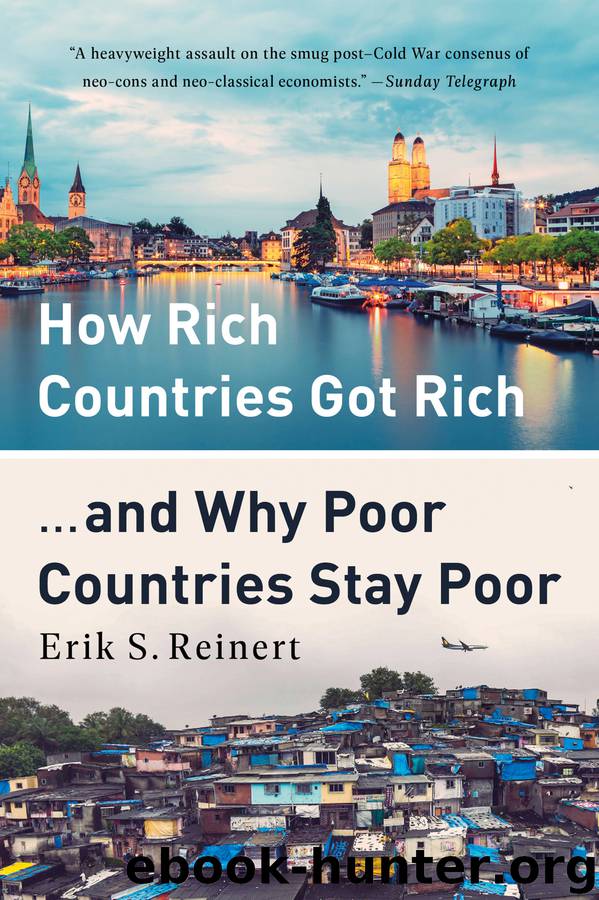How Rich Countries Got Rich ... and Why Poor Countries Stay Poor by Erik S. Reinert

Author:Erik S. Reinert
Language: eng
Format: epub
Publisher: PublicAffairs
Published: 2019-09-30T16:00:00+00:00
Figure 14 Peru, 1960–2000: Diverging Paths of Real Wages and Exports
This, however, brings us to an important point understood by economists for centuries, but which seems entirely incomprehensible to many of today’s economists: a country with an inefficient industrial sector is far better off than one with no industrial sector at all. Figure 14 shows the extent to which real wages in Peru sank dramatically with deindustrialization, and it is clear that we have produced a world economic order that maximizes world trade rather than world income. The argument used by the World Bank, and the economic theory that drives it, is that Peruvian industry was ‘inefficient’ and ‘not competitive’. My point is that this ‘inefficient’ industrial sector none the less created a wage level that was about twice as high as what today’s globalized economy is able to deliver in Peru. This shows up much more clearly in the wage statistics than in the statistics for gross domestic product. As wages fell, the mix of the financial sector, insurance and real estate (the FIRE sector: Financial, Insurance, Real Estate) has increased its share of total GDP considerably. Consequently the fall in people’s standard of living is much higher than it appears from looking at GDP figures.
If the world had taken Friedrich List’s path to economic integration and globalization, as Europe did with its internal market, globalization would have been a positive-sum game for all countries. The problem with globalization as it is practised today is that real wages fall drastically in the countries that are left behind, deindustrialized, in its wake. In fact, wages peaked in most Latin American countries around the same time they did in Peru. These countries, in fact, were richest when, according to the World Bank, they did everything wrong and protected their ineffective industries. Many countries in Asia, like Mongolia, did the same, and so did most of the countries in the former Second World, including Russia itself. There is little desire to discuss this, but the fact remains that the notoriously inefficient industries of the centrally planned economies in most cases created a far higher standard of living than capitalism does in the same countries today. Even when Estonia, portrayed as one of the big success stories, joined the EU in 2005, a worker producing mobile phones was paid an hourly wage of 1 Euro, less than one tenth of the income of someone sweeping the streets of Frankfurt or Paris. Having employed the same economic theories as those of globalization, Europe has created its own internal tensions similar to those present in the global economy.
The mechanisms we can observe in Peru, and which we shall later examine more closely in the case of Mongolia, make it extremely difficult to create middle-income countries. A national economy is either so strong that its industrial sector survives and it remains in the club of rich countries, or it is deindustrialized and ends up in the group racing to the bottom. The phenomenon is comparable to the problems facing national airlines today.
Download
This site does not store any files on its server. We only index and link to content provided by other sites. Please contact the content providers to delete copyright contents if any and email us, we'll remove relevant links or contents immediately.
International Integration of the Brazilian Economy by Elias C. Grivoyannis(57383)
The Radium Girls by Kate Moore(10915)
Turbulence by E. J. Noyes(7057)
Nudge - Improving Decisions about Health, Wealth, and Happiness by Thaler Sunstein(6642)
The Black Swan by Nassim Nicholas Taleb(6203)
Pioneering Portfolio Management by David F. Swensen(5615)
Rich Dad Poor Dad by Robert T. Kiyosaki(5162)
Zero to One by Peter Thiel(4834)
Man-made Catastrophes and Risk Information Concealment by Dmitry Chernov & Didier Sornette(4748)
Secrecy World by Jake Bernstein(3788)
Millionaire: The Philanderer, Gambler, and Duelist Who Invented Modern Finance by Janet Gleeson(3575)
Skin in the Game by Nassim Nicholas Taleb(3477)
The Age of Surveillance Capitalism by Shoshana Zuboff(3430)
The Money Culture by Michael Lewis(3291)
Skin in the Game: Hidden Asymmetries in Daily Life by Nassim Nicholas Taleb(3271)
Bullshit Jobs by David Graeber(3189)
The Dhandho Investor by Mohnish Pabrai(3175)
The Wisdom of Finance by Mihir Desai(3086)
Blockchain Basics by Daniel Drescher(2895)
